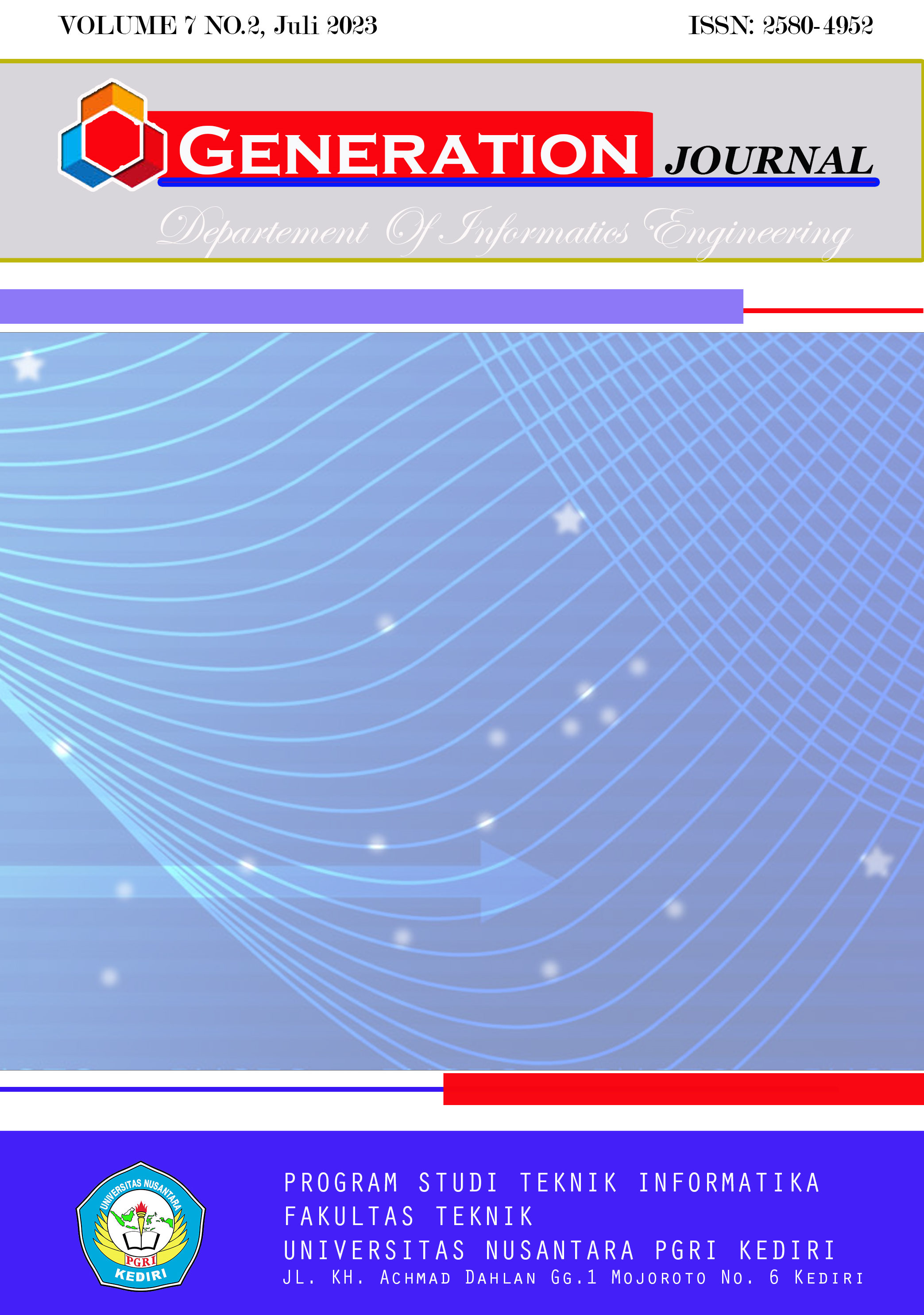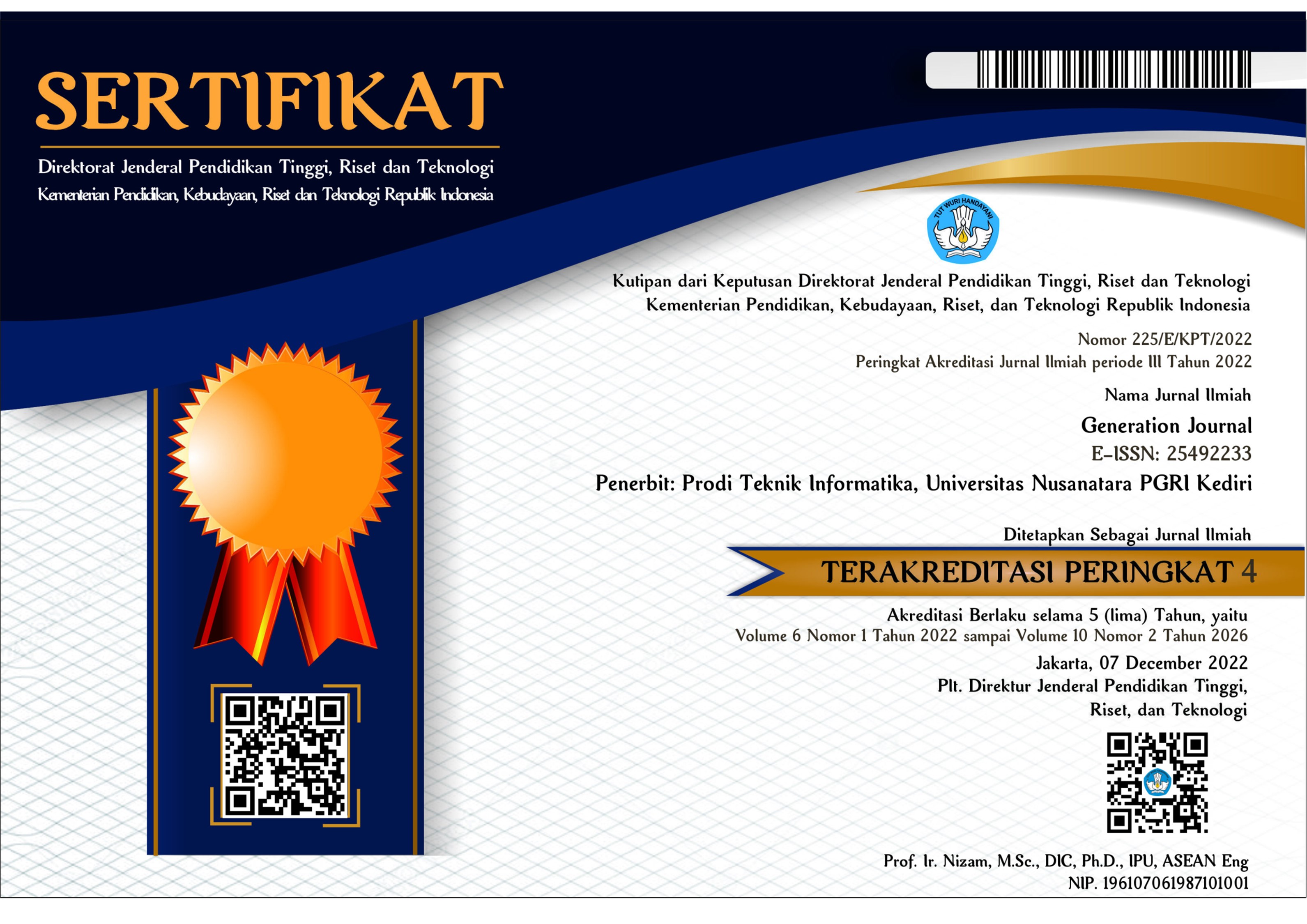Perbandingan Performa Algoritma KNN dan SVM dalam Klasifikasi Kelayakan Air Minum
DOI:
https://doi.org/10.29407/gj.v7i2.20270Keywords:
Water Potability, Machine Learning, K-Nearest Neighbors, Support Vector MachineAbstract
Air menjadi kebutuhan mendasar bagi kelangsungan makhluk hidup dan pembangunan. Saat ini, kesadaran masyarakat terhadap pola konsumsi air yang berkualitas dan bermutu semakin tinggi sehingga diperlukan penelitian terhadap kelayakan air. Dalam penelitian air tersebut menggunakan metode klasifikasi objek. Pada penelitian ini membahas perbandingan antara 2 metode Machine Learning yaitu K-Nearest Neighbors (K-NN) dengan Support Vector Machine (SVM) berdasarkan parameter yang telah ditentukan. Penelitian ini menghasilkan tingkat akurasi algoritme K-Nearest Neighbors (K-NN) sebesar 65,341% dan algoritme Support Vector Machine (SVM) menghasilkan akurasi sebesar 69,764%. Dari hasil tersebut, dapat disimpulkan bahwa algoritme Support Vector Machine (SVM) memiliki akurasi lebih tinggi daripada algoritme K-Nearest Neighbors (K-NN).
References
Gramedia. (2021). Mengenal Ciri-cifi Air Bersih Menurut WHO yang Aman Digunakan [online]. Available: https://www.gramedia.com/literasi/ciri-ciri-air-bersih/
SPARTA. (2023). Standar Kebutuhan Air Bersih Setiap Orang [online]. Available: https://www.atbbatam.com/?md=view&id=1-17070500012
WHO, “The Human Right to Water and Sanitation Media brief,” UN-Water Decad. Program. Advocacy Commun. Water Supply Sanit. Collab. Counc., no. April 2011, hal. 1–8, 2011, [Daring]. Tersedia pada: http://www.un.org/waterforlifedecade/pdf/human_right_to_water_and_sanitation_media_brief.pdf
U. Nations, “Sustainable Development Goal (SDG).” https://sdgs.un.org/
RimbaKita. (2023). Mata Air - Pengertian, Proses, Jenis, Manfaat & Pengelolaan [online]. Available: https://rimbakita.com/mata-air/
G. L. Pritalia, “Analisis Komparatif Algoritme Machine Learning pada Klasifikasi Kualitas Air Layak Minum,” vol. 2, 2022.
A. Kustanto, “Water quality in Indonesia: The role of socioeconomic indicators,” J. Ekon. Pembang., vol. 18, no. 1, pp. 47–62, Jul. 2020, doi: 10.29259/jep.v18i1.11509.
C. T. Son, N. T. H. Giang, T. P. Thao, N. H. Nui, N. T. Lam, and V. H. Cong, “Assessment of Cau River water quality assessment using a combination of water quality and pollution indices,” J. Water Supply Res. Technol.-Aqua, vol. 69, no. 2, pp. 160–172, Mar. 2020, doi: 10.2166/aqua.2020.122.
I. G. Vidiastanta, N. Hidayat, and R. K. Dewi, “Komparasi Metode K-Nearest Neighbors (K-NN) Dengan Support Vector Machine (SVM) Untuk Klasifikasi Status Kualitas Air”. [10] Kadiwal Aditya. 2021. Water Quality [online]. available: https://www.kaggle.com/datasets/adityakadiwal/water-potability
Jamari Untung. (2022, Maret 20). PENJELASAN CARA KERJA ALGORITMA K-NEAREST NEIGHBOR (KNN) [online]. available: http://labdas.si.fti.unand.ac.id/2022/03/20/ penjelasan-cara-kerja-algoritma-k-nearest-neighbor-knn/
Spyder. (2023). Ringkasan [online]. available: https://www.spyder-ide.org/
Kaggle. (2018). Oprec Ristek 2018 - Data Science [online]. available: https://www.kaggle.com/competitions/oprecristekds/overview/description
Lawton George (2022, Januari). DEFINISI prapemrosesan data [online]. available: https://www.techtarget.com/searchdatamanagement/definition/data-preprocessing
Science Data in Master's. (2023). Cara Mengatasi Data Hilang [online]. available: https://www.mastersindatascience.org/learning/how-to-deal-with-missing-data/
Afifah Lutfia (2023). Apa Itu Bias dan Variance di Machine Learning? [online]. available: https://ilmudatapy.com/apa-itu-bias-dan-variance-di-machine-learning/
Mufadhol. (2022, Mei 13). Perbedaan Data Training Dan Data Testing [online]. available: https://teknik-informatika-s1.stekom.ac.id/informasi/baca/Perbedaan-Data-Training-dan-Data-Testing/d475bd43bdae3488afe8a0f648ee5671fb6cdc40
A. R. Isnain, A. I. Sakti, D. Alita, and N. S. Marga, “SENTIMEN ANALISIS PUBLIK TERHADAP KEBIJAKAN LOCKDOWN PEMERINTAH JAKARTA MENGGUNAKAN ALGORITMA SVM,” J. Data Min. Dan Sist. Inf., vol. 2, no. 1, p.
, Feb. 2021, doi: 10.33365/jdmsi.v2i1.1021
G. Gunawan and Y. Reswan, “DESAIN APLIKASI PENGENALAN POLA TANDA TANGAN MENGGUNAKAN METODE SUPPORT VECTOR MACHINE (SVM),” J. MEDIA INFOTAMA, vol. 17, no. 1, Feb. 2021, doi: 10.37676/jmi.v17i1.1311.
Anggreany Susan Maria. (2020). Confusion Matrix [online]. available: https://socs.binus.ac.id/2020/11/01/confusion-matrix/
Downloads
Published
Issue
Section
License
Authors who publish with this journal agree to the following terms:
- Copyright on any article is retained by the author(s).
- The author grants the journal, the right of first publication with the work simultaneously licensed under a Creative Commons Attribution License that allows others to share the work with an acknowledgment of the work’s authorship and initial publication in this journal.
- Authors are able to enter into separate, additional contractual arrangements for the non-exclusive distribution of the journal’s published version of the work (e.g., post it to an institutional repository or publish it in a book), with an acknowledgment of its initial publication in this journal.
- Authors are permitted and encouraged to post their work online (e.g., in institutional repositories or on their website) prior to and during the submission process, as it can lead to productive exchanges, as well as earlier and greater citation of published work.
- The article and any associated published material is distributed under the Creative Commons Attribution-ShareAlike 4.0 International License














